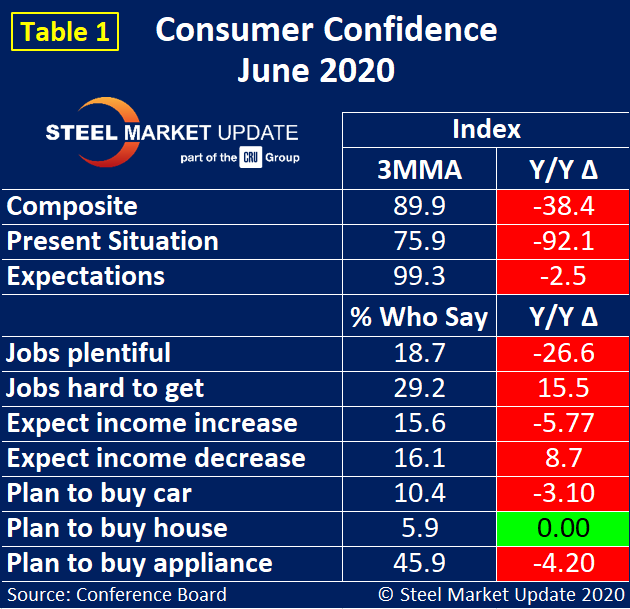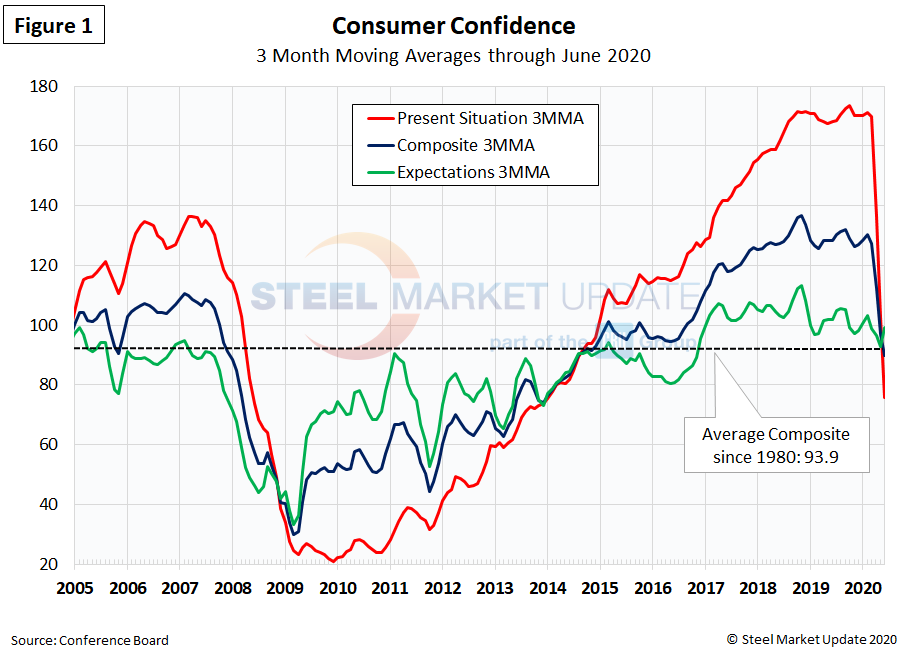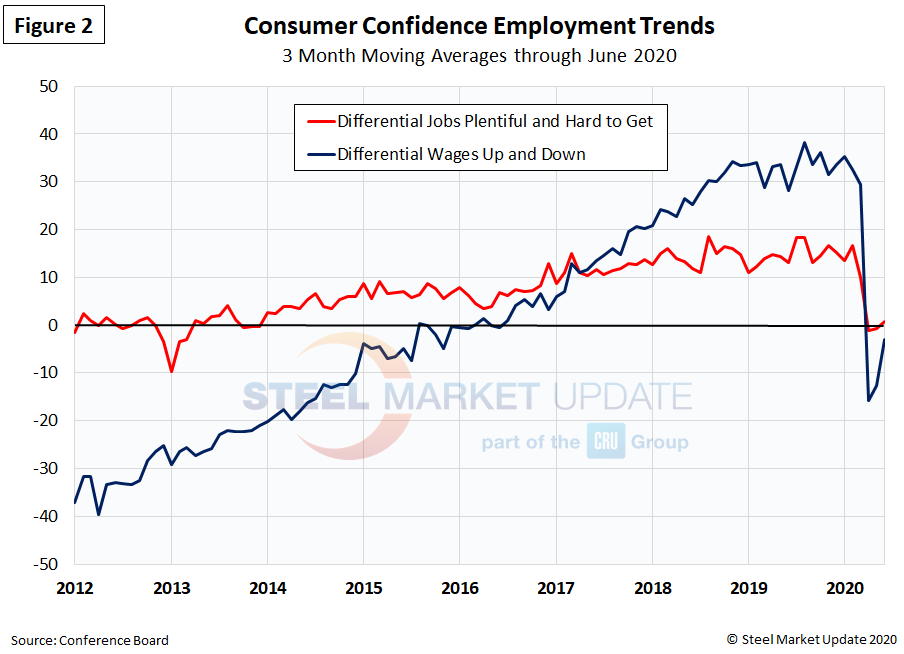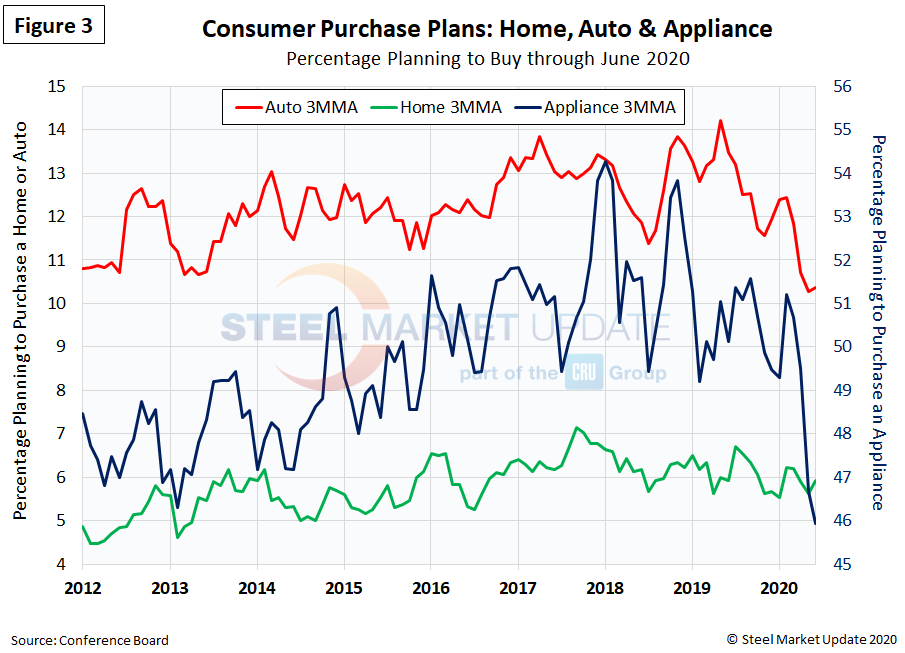Economy

Consumer Confidence Improves in June
Written by Brett Linton
July 7, 2020
The Conference Board Employment Trends Index (ETI) increased in June, further stabilizing from sharp declines in recent months. The index now stands at 49.05, up from 45.27 in May. However, the index is still down 54.8 percent from a year ago. “The Employment Trends Index increased for the second consecutive month, but the virus’s recent proliferation threatens those gains and puts the U.S. labor market’s future in an even more precarious position,” said Gad Levanon, head of The Conference Board Labor Markets Institute. “In response to this resurgence, many governments have delayed or reversed their reopening plans, which could lead to lower hiring. Given the possibility of less recruiting and the fact that layoff rates remain high, the upward trend in the number of jobs may not continue. The unemployment rate may plateau or even increase in the coming months.”
Steel Market Update takes data from The Conference Board and presents it as a three-month moving average to smooth the trend. It’s been three months since the coronavirus shut down the U.S. economy, and the trend is clear. The composite index is made up of two sub-indexes: the consumer’s view of the present situation and his or her expectations for the future. On a 3MMA basis comparing June 2020 with June 2019, the present situation was down by 92.1 points and expectations were down by 2.5 points (Table 1). The color codes show improvement or deterioration of the individual components in Table 1. The red indicates that consumer confidence is negative in all aspects except plans to buy a house. The housing market has remained surprisingly resilient as the economy struggles with the effects of the virus.

In June, the consumers’ view of the present situation registered 75.9 as a 3MMA, down sharply from 170.0 in March just prior to the start of the pandemic. Consumer expectations actually saw some improvement from May to June as coronavirus restrictions eased, moving up from a 3MMA of 92.9 in May to 99.3 in June. The composite index now stands at a 3MMA of 89.9, down from 96.8 in May and down from the 2020 peak of 130.4 in February. Consumers’ expectations for the future are more positive than their current sentiment (Figure 1).

The consumer confidence report includes employment data that shows some positive labor trends. Figure 2 shows the 3MMA differential between the positive and negative statistics for employment and wages. In March, pre-pandemic, the differential between consumers who said jobs were plentiful and those who said jobs were hard to get was +9.9. After dipping briefly into negative territory in April, the 3MMA saw an uptick in June to +0.7. Expectations for wage increases also trended upward, rising from a reading of -15.7 in April to -3.0 in June. Consumer attitudes improved somewhat in June as businesses reopened and more people got back to work.

Consumers’ plans to purchase homes, autos and appliances all dropped dramatically in the first quarter as the coronavirus took hold of the economy. Attitudes toward home and auto purchases saw slight upticks in June as the labor market improved (Figure 3).

Steel demand is dependent on the growth of GDP, which in turn is strongly influenced by consumer confidence, disposable income and a willingness to spend. The June data shows early signs of improvements in consumer attitudes, but those gains could easily reverse if a resurgence of COVID-19 shuts down parts of the economy once again.
About The Conference Board: The Conference Board is a global, independent business membership and research association working in the public interest. The monthly Consumer Confidence Survey®, based on a probability-design random sample, is conducted for The Conference Board by Nielsen. The index is based on 1985 = 100. The composite value of consumer confidence combines the view of the present situation and of expectations for the next six months.

Brett Linton
Read more from Brett LintonLatest in Economy

Industry groups praise Senate for passing tax and budget bill
The Steel Manufacturers Association and the American Iron and Steel Institute applauded the tax provisions included in the Senate's tax and budget reconciliation bill.

Chicago PMI dips 0.1 points in June
The Chicago Purchasing Managers Index (PMI) slipped 0.1 points to 40.4 points, in June.

Multi-family pullback drives housing starts to 5-year low in May
US housing starts tumbled in May to a five-year low, according to figures recently released by the US Census Bureau.

Architecture firms still struggling, ABI data shows
Architecture firms reported a modest improvement in billings through May, yet business conditions remained soft, according to the latest Architecture Billings Index (ABI) release from the American Institute of Architects (AIA) and Deltek.

Manufacturing in New York state contracts again
However, companies are growing more optimistic about the future.
